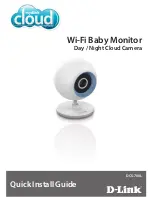
BULLETIN E-90-WMS
Model WMS Wireless Temperature Monitor
Specifications– Installation and Operating Instructions
DWYER INSTRUMENTS, INC.
Phone: 219/879-8000
www.dwyer-inst.com
P.O. BOX 373 • MICHIGAN CITY, INDIANA 46361, ,U.S.A. Fax: 219/872-9057
e-mail: [email protected]
Lit-By Fax: 888/891-4963
DESCRIPTION
Simultaneously monitor local and remote temperatures with the Model
WMS10 Wireless Temperature Monitor. Simply place the remote sensor at
any location up to 100 ft. (30 m) away from the receiver—no additional
setup is required.
BEFORE YOU BEGIN
For best operation read through instructions first:
1.
Assign different channels to as many as three (3) Remote Sensors.
Additional sensors can be purchased as Model WMS5.
2.
Insert batteries for Remote Sensor before doing so for the Receiver.
3.
Place the Receiver as close as possible to the remote sensor. Press the
RESET button after installing batteries. This will ensure easier synchro-
nization between the transmission and reception of signals.
4.
Position the Remote Sensor and Receiver within effective transmission
range, which, in usual circumstances, is 100 feet (30 m).
Note:
The effective range is vastly affected by the building materials and
where the Receiver and Remote Sensor are positioned. Try various set-ups
for the best result.
Though the Remote Sensor is weather proof, it should be placed away from
direct sunlight, rain, snow, and should never be submerged in water.
BATTERY INSTALLATION
Remote Sensor (includes Channel Selection)
The Remote Sensor operates on two (2) AAA size alkaline batteries.
Note:
It is important to insert batteries in the Remote Sensor and select
channel before starting Receiver. To install the batteries:
1.
Loosen the screws on the battery compartment.
2.
While battery compartment is open it is a good idea to select the
channel number on the CHANNEL slide switch.
3. Insert the batteries as indicated by the polarity symbols (+ and -)
marked inside the battery compartment.
4. Replace the battery compartment door.
Receiver
The receiver operates on two (2) AA size alkaline batteries. To install the
batteries:
1.
Slide open the battery compartment.
2.
Insert the batteries as indicated by the polarity symbols
(+ and -) marked inside the battery compartment.
4.500
[114.30]
1.000
[25.40]
5.000
[127.00]
3.500
[88.90]
1.000
[25.40]
2.250
[57.15]
PHYSICAL DATA
Operating Range:
-4˚F to 122˚F (-20˚C to 50˚C).
Temperature Resolution:
0.2˚F (0.1˚C).
RF Transmission Frequency:
433 MHz.
RF Transmission Range:
100 ft. (30m) maximum.
Temperature Sensing Cycle:
Approximately 30 seconds.
Weight:
Remote Sensor: 3.5 oz (100 g); Receiver: 9 oz (50 g).
Mounting:
Table stand or wall mountable.
Display:
Large, 2” dual LCD.
Power:
Four AA Alkaline batteries (2 per unit). Not included.
3.
Replace the battery door.
Note:
Replace the batteries when the low battery indicator of the particular
channel lights up on the Receiver. (Repeat the steps described in section
“Before You Begin”.)
GENERAL OPERATION
Once batteries are in place for the Remote Sensor, it will start transmitting
temperature readings at 30 second intervals.
The receiver will start searching for signals for about a minute once the
batteries are installed. Upon successful reception, the individual channel
temperatures will be displayed on the top of the display and the
indoor
temperature (measured at the receiver) on the bottom of the display.
The Receiver will automatically update its readings at 30 second inter-
vals. If no signals are received, blanks “- - -” will be displayed and the
kinetic wave icon will show. Press CHANNEL and HIGH/LOW
MEMORY Button (on front) simultaneously to enforce another search
(about 30 seconds). This is useful in synchronizing the transmission
and reception of the remote sensor(s) and receiver.




















